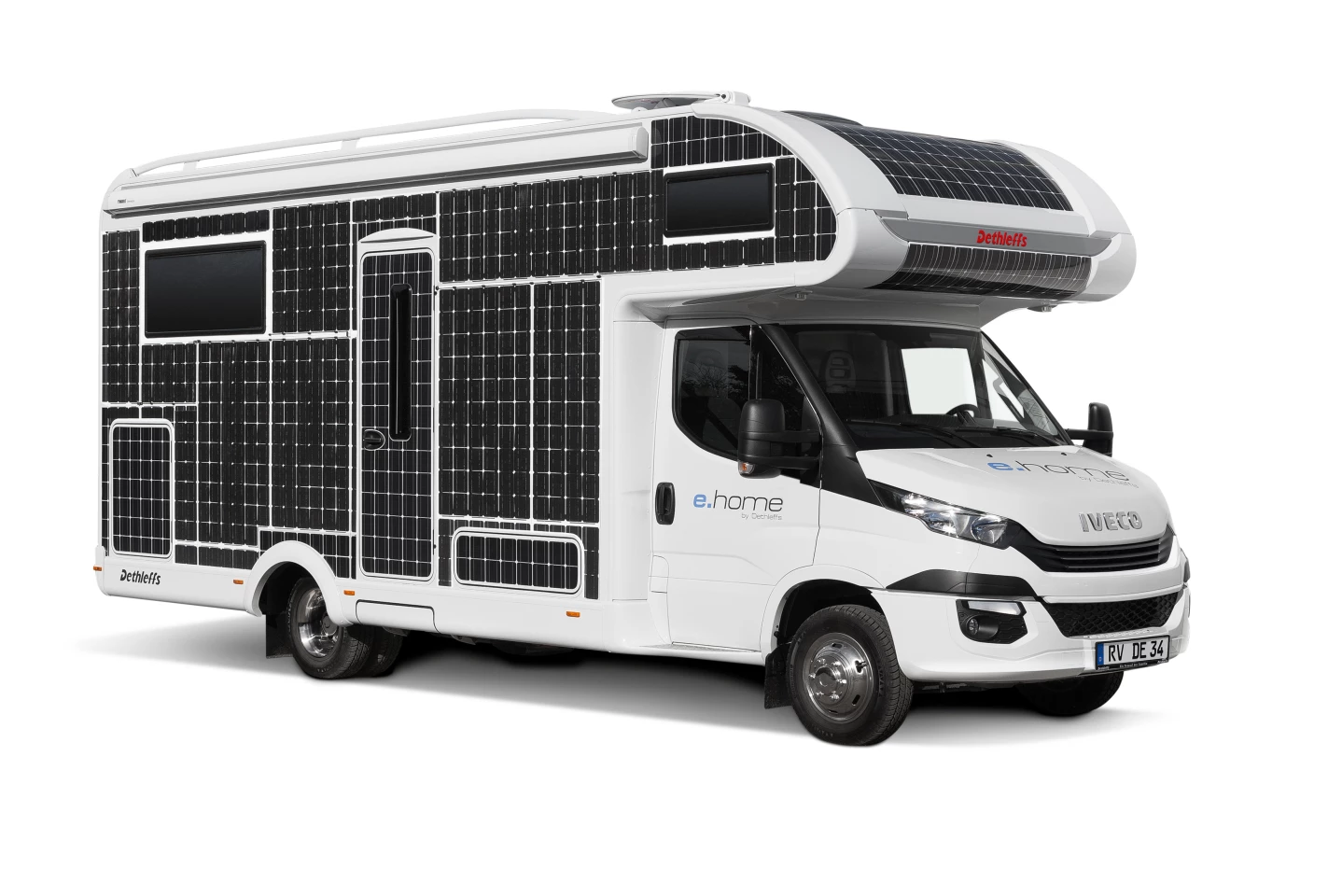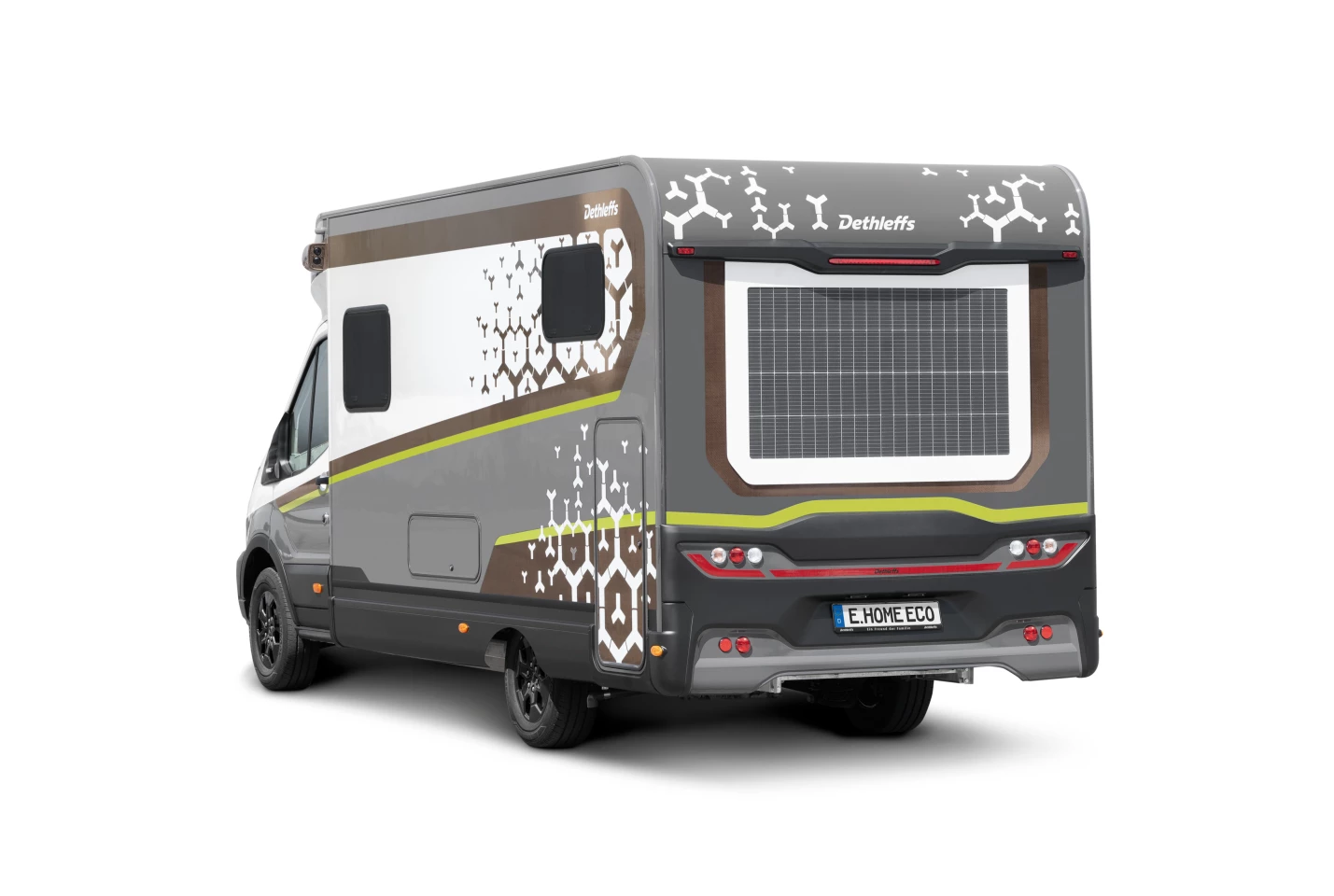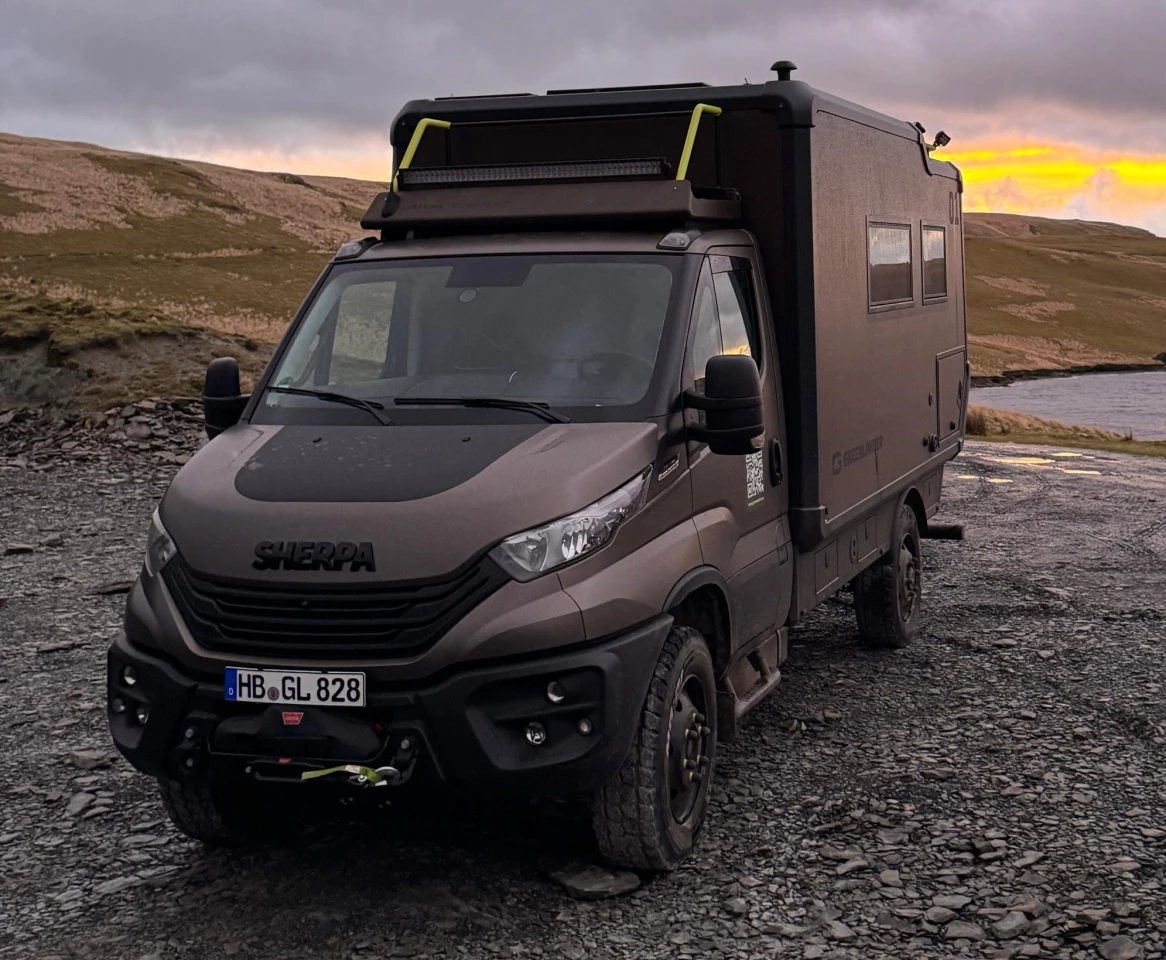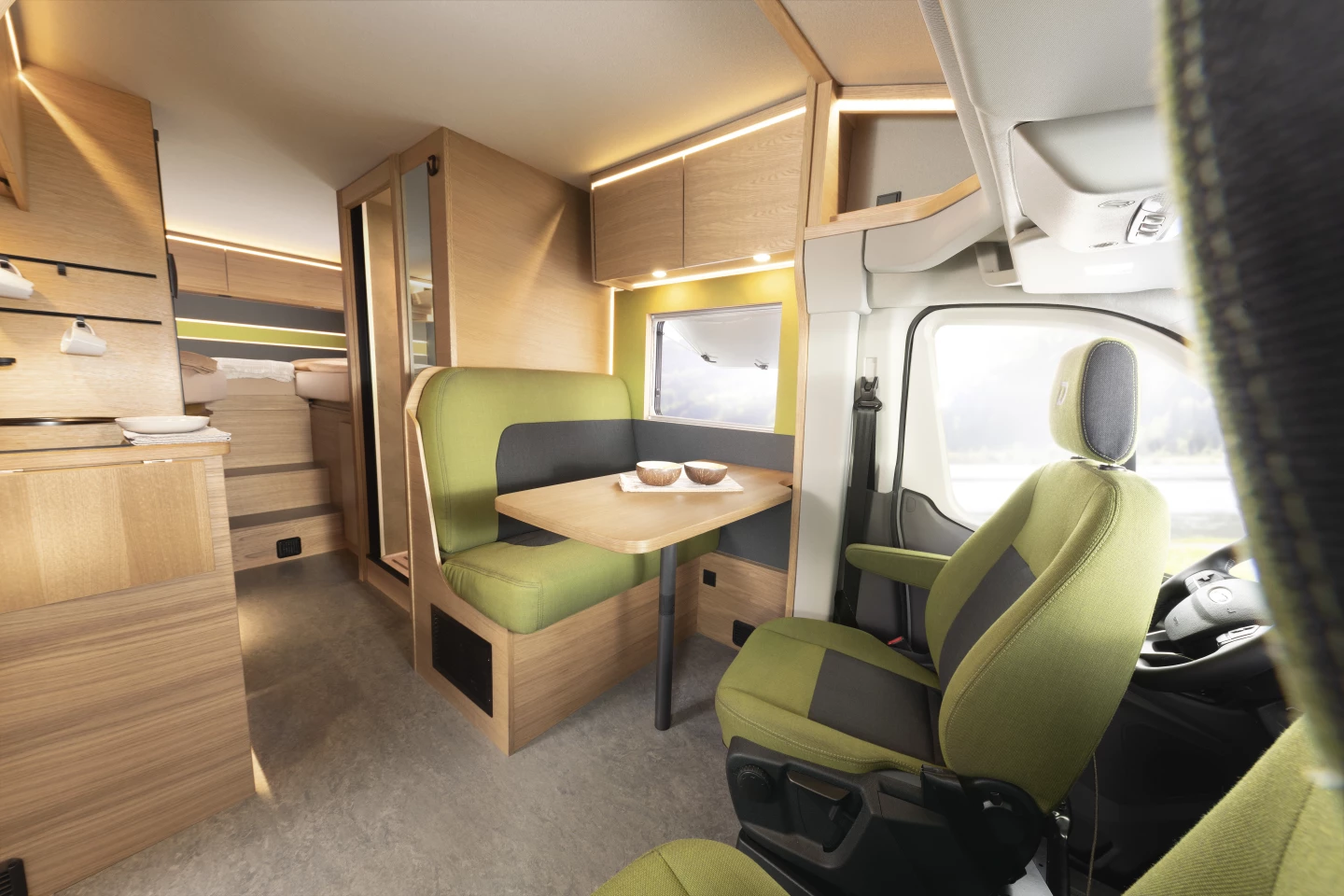The annual Düsseldorf Caravan Salon is approaching quickly, and Dethleffs is gearing up to show one of its most innovative, ground-up rethinks yet. Following in the German brand’s long-running tradition of eco-friendly Düsseldorf show vehicles, the E.Home Eco features a highly sustainable construction atop an all-electric Ford chassis. Gone is the usual array of synthetic materials, replaced with more natural alternatives like a flax-composite shell, corn furniture and sheep’s wool upholstery.
With roots gnarling all the way back to 1931, Dethleffs is one of the caravan industry’s pioneers at large, and in 2017, it emerged as one of the industry’s trailblazers in sustainable innovation. Who can forget the solar panel-covered E.Home concept it presented that year, or the E.Home Coco concept with which it followed it up? The latter kickstarted the idea of a self-propelled motorized trailer just now making its way to market. In 2019, Dethleffs picked up the lead on camper van electrification, debuting the production-bound plug-in hybrid Globevan camper.

Dethleffs
Interestingly, it was Dethleffs’ sister Erwin Hymer Group brand Bürstner that showed the first all-electric Ford Transit-based camper van in 2022. Dethleffs was seemingly on a hiatus from green concepts and launches for a few years, focusing in on developing an adventurous lineup of compact, thrill-seeking AWD and toy-hauling motorhomes.
Now Dethleffs is back in the driver’s seat of the envelope-pushing eco-RV game, and it’s previewing what the next generation of environmentally influenced design could look like in RV manufacturing. The company notes that while its previous eco models were centered around electrification of powertrain and onboard RV equipment, its new direction will extend beyond vehicle usage into material selection and supply strategies.
That doesn’t mean it’s pulling back on electrification, though – the E.Home Eco concept still starts with an all-electric base vehicle. Dethleffs one-ups Bürstner’s E-Transit camper van with a larger E-Transit Class C motorhome. The company says the MY2023 E-Transit brings 181 hp of drive power and a 149-mile (240-km) WLTP range.
Dethleffs’ technical team has worked hard to make the most out of the E-Transit’s limited range by optimizing aerodynamics. It’s replaced the side mirrors with a rear-view camera system, swapped the rear wheel arches for dropped bodywork and pulled off roof components for smoother airflow, all to help eke out every last mile-per-charge.

Dethleffs
Sustainable materials aren’t quite as flashy and attention-grabbing as electric powertrain technologies, but they’ve begun to find experimental and nascent production use in RVs and the mobility industry at large. For its part, Dethleffs foregoes the common fiberglass motorhome box construction in favor of a flax composite supplied by German specialist Greenboats.
Greenboats developed its flax-based natural fiber composite materials for the boat industry back in 2013 and has since expanded into other industries, including sporting goods and RVs, through spinoff brand Circular Structures. Last year’s Düsseldorf Caravan Salon welcomed the Greenlander Sherpa, an Iveco Daily 4×4-based overland expedition vehicle with a living module made out of Circular Structures’ flax composite. The first production run has actually sold out, but Greenlander is planning future runs atop the Mercedes-Benz Sprinter AWD and Atego.

Greenlander
The flax composite in use in the E.Home Eco’s construction doesn’t eliminate plastic completely because the natural fibers are still set in a resin, just as glass fibers would be in fiberglass. Dethleffs does stress that the resin in this case features 40 percent natural content, including linseed oil from the same type of plants from which the flax is harvested. According to Dethleffs, the flax fibers themselves offer comparable structural properties to glass but with a carbon footprint that’s 80 percent lower.
To insulate those naturally flaxxy walls, Dethleffs uses a foam made from recycled PET bottles, something we’ve seen from other RV manufacturers, including Escapod. Dethleffs says that the material is also recyclable, allowing it to be repurposed at the end of the RV’s lifecycle.
The material switch-up continues inside, where Dethleffs uses something we don’t recall coming across in the past: “popcorn panels.” Made from non-food-grade maize, the material was developed in 2018 at Germany’s University of Göttingen and has been continually refined in the years since. It’s encased within outer veneers made from oiled oak, offering properties comparable to plywood but with a claimed half the weight. The E.Home Eco uses it in the kitchen counter and dining table tops.
The floor below those furnishings is made from quite a natural little formulation of linoleum that incorporates a mix of jute fabric, linseed oil, cork flour and natural resins. The upholstery fabric, meanwhile, is a processed sheep’s wool, promising a warm, comfortable feel and durable, stain-resistant, flame-retardant performance.

Dethleffs
Like the original 2017 E.Home, the E.Home Eco is designed to run completely on electrical power, far more common in campers today than eight years ago. Dethleffs doesn’t shoot for an entirely self-sufficient, off-grid electrical system, however, tapping into shore power to run a heat pump and separate water heater, both supplied by Truma. The low-noise heat pump distributes heating through floor ducts, assisted by electrical boosters that accelerate heating of the air. Cooling is supplied through ceiling ducts.
The E.Home Eco doesn’t include the full-body solar suit of the original E.Home, but Dethleffs has integrated a little more than half the original concept’s capacity, installing 1,700 watts of panels more subtly on the roof and rear wall to power the onboard battery.
“In our development projects, we routinely evaluate new materials based on renewable or recycled raw materials, as well as environmentally friendly innovations from our suppliers, to determine their practicality in caravanning applications,” said Dethleffs Managing Director Bernhard Kibler. “Some of these approaches may find their way into production vehicles in the future, while others still need to prove their practical viability.”
In other words, the E.Home Eco is not meant to be a direct preview of a production model. Then again, Hymer brass had a sentiment very similar to Kibler’s about the then-highly exotic 2019 Vision Venture camper van concept before bringing it to market three years later, most of its impressive, otherworldly features still intact.
So maybe most of the E.Home Eco’s approaches end up proving their “practical viability” to the point Dethleffs sends the whole vehicle through to production lines.
We’ll get a closer look at the E.Home Eco concept once the 2025 Caravan Salon gets underway in August.
Source: Dethleffs








